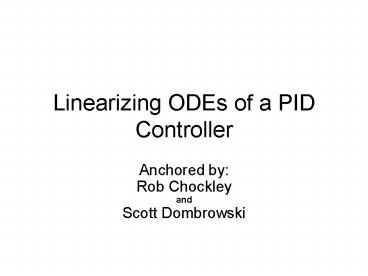Linearizing ODEs of a PID Controller - PowerPoint PPT Presentation
1 / 9
Title:
Linearizing ODEs of a PID Controller
Description:
We are using a PID controller to maintain the tank pressure at a constant pressure of 8 atm. ... bias. 0.6. Kc. 0.3. Ti. 100. Td. 0.1. Linearization of dP/dt Again ... – PowerPoint PPT presentation
Number of Views:83
Avg rating:3.0/5.0
Title: Linearizing ODEs of a PID Controller
1
Linearizing ODEs of a PID Controller
- Anchored by
- Rob Chockley
- and
- Scott Dombrowski
2
Basis for Linearization
Ordinary Differential Equation
Taylor Series Expansion
Linear Approximation
3
Real Life Example
- For our example, we created a real world
situation. - In 3 mol/s (const)
- Out Controlled by PID
- We are using a PID controller to maintain the
tank pressure at a constant pressure of 8 atm.
4
Linearizing Our Model
- Our system is being controlled by a PID
controller. - The first equation models the differential
pressure change. - The second equation is the controller output.
- The third is the function is the first step of
linearization. F(P) is equal to the combined
model of the differential pressure change. - Finally, the four equation is the derivative of
the function f(P). This is used in the
linearization model at the steady state pressure
of 8 atm.
5
Model for the System
- The graph to the right is the model for the
system. The pressure within the tank is being
controlled by the valve. The valve is being
throttled according to the output from the
sensor. - The pressure fluctuates a great deal at the
beginning of the run but eventually reaches
steady state at our desired pressure.
Gas Flow into a Tank Controlling Pressure using a PID Controller Gas Flow into a Tank Controlling Pressure using a PID Controller Gas Flow into a Tank Controlling Pressure using a PID Controller Gas Flow into a Tank Controlling Pressure using a PID Controller Gas Flow into a Tank Controlling Pressure using a PID Controller
timestep 1 s
V 100 L tank volume tank volume
T 300 K tank temperature tank temperature
R 0.08206 Latm/molK gas constant gas constant
nin 3 mol/s flow rate in flow rate in
F 5 mol/s max flow rate out max flow rate out
ni 40 mol initial tank contents initial tank contents
Pinitial 9.8472 atm initial tank pressure initial tank pressure
Pset 8 atm tank set point tank set point
bias 0.6
Kc 0.1
Ti 10
Td 0.1
6
Linearization of dP/dt
- This graph shows the plot of
- dP/dt vs. P and the linear approximation from a
truncated linear expansion. - Because the pressure oscillated there are
multiple values of dP/dt for one pressure. - The linearization is not a good approximation for
the behavior of the differential equation.
7
Linear Approximation behaving Like Nonlinear
Function
- We change the coefficients within the model to
create a new behavior. - Here, the ratio of change in the output to the
change in input is three time what it was
previously , and the Integral time is 10 times
than before. - Here the desired pressure is reached more
quickly.
Gas Flow into a Tank Controlling Pressure using a PID Controller Gas Flow into a Tank Controlling Pressure using a PID Controller Gas Flow into a Tank Controlling Pressure using a PID Controller Gas Flow into a Tank Controlling Pressure using a PID Controller Gas Flow into a Tank Controlling Pressure using a PID Controller Gas Flow into a Tank Controlling Pressure using a PID Controller
timestep 1 s
V 100 L tank volume tank volume
T 300 K tank temperature tank temperature
R 0.08206 Latm/molK gas constant gas constant
nin 3 mol/s flow rate in flow rate in
F 5 mol/s max flow rate out max flow rate out
ni 40 mol initial tank contents initial tank contents
Pinitial 9.8472 atm initial tank pressure initial tank pressure
Pset 8 atm tank set point tank set point
bias 0.6
Kc 0.3
Ti 100
Td 0.1
8
Linearization of dP/dt Again
- For this trial the model had no oscillation so
the nonlinear equations that govern the change in
pressure are more easily linearized.
9
Conclusion
This walkthrough and model shows that linearizing
nonlinear equations is not always the best idea.
The PID controller creates instances where the
differential of pressure is not an independent
function of one variable. Under certain
conditions, however, The model can be use. These
models may not occur in real life.

